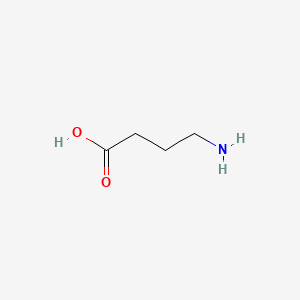4-aminobutyric acid
4-aminobutyric acid is a lipid of Fatty Acyls (FA) class. 4-aminobutyric acid is associated with abnormalities such as Epilepsy and Premenstrual syndrome. The involved functions are known as Binding (Molecular Function), neuron survival, Process, Uptake and physiological aspects. 4-aminobutyric acid often locates in Microglial, Neurofilament, Neuraxis, Brain region and Neurites. The associated genes with 4-aminobutyric acid are arginine methyl ester, SLC33A1 gene, NKS1 gene, P4HTM gene and ITSN2 gene. The related lipids are pregnenolone sulfate, pregnane-20-one, Pregnanes, Steroids and endogenous steroids.
Cross Reference
Introduction
To understand associated biological information of 4-aminobutyric acid, we collected biological information of abnormalities, associated pathways, cellular/molecular locations, biological functions, related genes/proteins, lipids and common seen animal/experimental models with organized paragraphs from literatures.
What diseases are associated with 4-aminobutyric acid?
4-aminobutyric acid is suspected in Premenstrual syndrome, Epilepsy and other diseases in descending order of the highest number of associated sentences.
Related references are mostly published in these journals:
| Disease | Cross reference | Weighted score | Related literature |
|---|
Possible diseases from mapped MeSH terms on references
We collected disease MeSH terms mapped to the references associated with 4-aminobutyric acid
PubChem Associated disorders and diseases
What pathways are associated with 4-aminobutyric acid
There are no associated biomedical information in the current reference collection.
PubChem Biomolecular Interactions and Pathways
Link to PubChem Biomolecular Interactions and PathwaysWhat cellular locations are associated with 4-aminobutyric acid?
Visualization in cellular structure
Associated locations are in red color. Not associated locations are in black.
Related references are published most in these journals:
| Location | Cross reference | Weighted score | Related literatures |
|---|
What functions are associated with 4-aminobutyric acid?
Related references are published most in these journals:
| Function | Cross reference | Weighted score | Related literatures |
|---|
What lipids are associated with 4-aminobutyric acid?
Related references are published most in these journals:
| Lipid concept | Cross reference | Weighted score | Related literatures |
|---|
What genes are associated with 4-aminobutyric acid?
Related references are published most in these journals:
| Gene | Cross reference | Weighted score | Related literatures |
|---|
What common seen animal models are associated with 4-aminobutyric acid?
There are no associated biomedical information in the current reference collection.
NCBI Entrez Crosslinks
All references with 4-aminobutyric acid
Download all related citations| Authors | Title | Published | Journal | PubMed Link |
|---|---|---|---|---|
| Meye FJ et al. | Morphine withdrawal enhances constitutive μ-opioid receptor activity in the ventral tegmental area. | 2012 | J. Neurosci. | pmid:23152596 |
| Geng Y et al. | Triptolide down-regulates COX-2 expression and PGE2 release by suppressing the activity of NF-κB and MAP kinases in lipopolysaccharide-treated PC12 cells. | 2012 | Phytother Res | pmid:21717513 |
| Hazell GG et al. | G protein-coupled receptors in the hypothalamic paraventricular and supraoptic nuclei--serpentine gateways to neuroendocrine homeostasis. | 2012 | Front Neuroendocrinol | pmid:21802439 |
| Perego C et al. | Neurosteroid allopregnanolone regulates EAAC1-mediated glutamate uptake and triggers actin changes in Schwann cells. | 2012 | J. Cell. Physiol. | pmid:21688266 |
| Lin PP et al. | Inhibition of cardiac hypertrophy by probiotic-fermented purple sweet potato yogurt in spontaneously hypertensive rat hearts. | 2012 | Int. J. Mol. Med. | pmid:23064753 |
| Hagerman R et al. | Fragile X syndrome and targeted treatment trials. | 2012 | Results Probl Cell Differ | pmid:22009360 |
| Bracamontes JR et al. | A neurosteroid potentiation site can be moved among GABAA receptor subunits. | 2012 | J. Physiol. (Lond.) | pmid:22988137 |
| Li WR et al. | Pharmacokinetics of natural borneol after oral administration in mice brain and its effect on excitation ratio. | 2012 | Eur J Drug Metab Pharmacokinet | pmid:21948240 |
| Wang M et al. | Acute restraint stress enhances hippocampal endocannabinoid function via glucocorticoid receptor activation. | 2012 | J. Psychopharmacol. (Oxford) | pmid:21890595 |
| Garrido P et al. | Aging impairs the control of prefrontal cortex on the release of corticosterone in response to stress and on memory consolidation. | 2012 | Neurobiol. Aging | pmid:21794953 |
| Bosch OG et al. | Reconsidering GHB: orphan drug or new model antidepressant? | 2012 | J. Psychopharmacol. (Oxford) | pmid:21926421 |
| Lucenteforte E et al. | Complementary and Alternative Drugs Use among Preoperative Patients: A Cross-Sectional Study in Italy. | 2012 | Evid Based Complement Alternat Med | pmid:21822441 |
| Lecker I et al. | Tranexamic acid concentrations associated with human seizures inhibit glycine receptors. | 2012 | J. Clin. Invest. | pmid:23187124 |
| Al-Wadei HA et al. | Social stress promotes and γ-aminobutyric acid inhibits tumor growth in mouse models of non-small cell lung cancer. | 2012 | Cancer Prev Res (Phila) | pmid:21955519 |
| López-López J et al. | Inferior alveolar nerve injury resulting from overextension of an endodontic sealer: non-surgical management using the GABA analogue pregabalin. | 2012 | Int Endod J | pmid:21883296 |
| Benjaminsen E et al. | A man in his seventies with prolonged myasthenic crisis. | 2012 | Tidsskr. Nor. Laegeforen. | pmid:23076489 |
| Uetake K et al. | Calming effect of orally administered γ-aminobutyric acid in Shih Tzu dogs. | 2012 | Anim. Sci. J. | pmid:23216545 |
| Duszczyk-Budhathoki M et al. | Administration of thimerosal to infant rats increases overflow of glutamate and aspartate in the prefrontal cortex: protective role of dehydroepiandrosterone sulfate. | 2012 | Neurochem. Res. | pmid:22015977 |
| Maschio M et al. | Effect of pregabalin add-on treatment on seizure control, quality of life, and anxiety in patients with brain tumour-related epilepsy: a pilot study. | 2012 | Epileptic Disord | pmid:23248037 |
| Rossi S et al. | Interleukin-1β causes anxiety by interacting with the endocannabinoid system. | 2012 | J. Neurosci. | pmid:23035099 |
